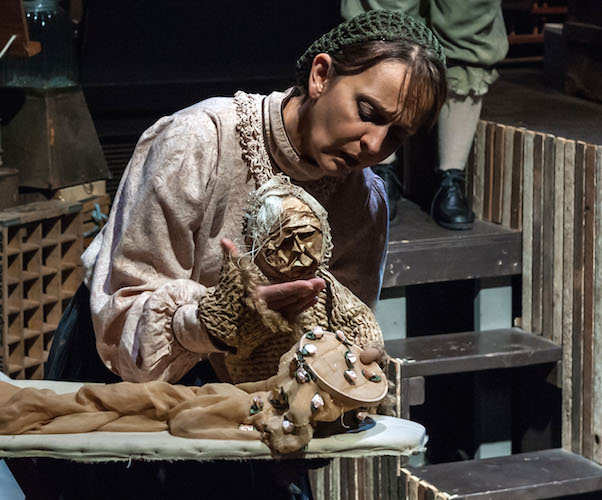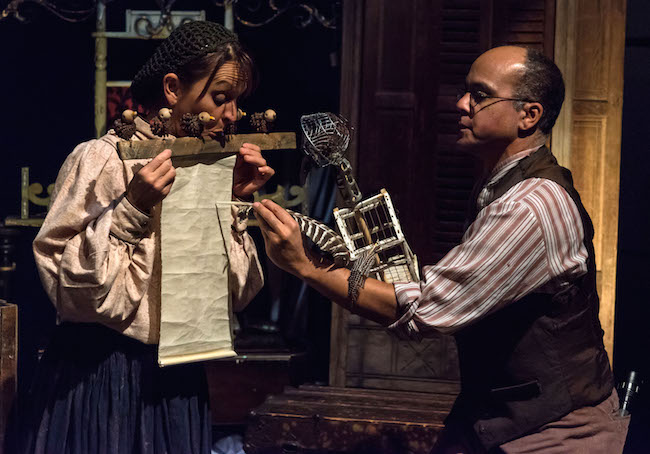Theater Review: URT’s “Matchless” & “The Happy Prince” — Enchanting Worlds
The Underground Railway Theater serves up an hour and fifteen minutes of enchantment, heartfelt theatrical magic that is becoming harder and harder to come by.
Matchless by Gregory Maguire & The Happy Prince by Oscar Wilde. Directed by Debra Wise. Presented by Underground Railway Theater at Central Square Theater, Cambridge, MA Through December 31.

Tess Degen in the Underground Railway Theater’s production of “Matchless” & “The Happy Prince.” Photo: A.R. Sinclair Photography.
By Ian Thal
As the audience members take their seats at the blackbox space at Central Square Theater, they have several minutes to admire scenic designer David Fichter’s carefully constructed set made up of discarded furniture, crates, appliances and knick-knacks (some found-object assemblage pieces by the late Fay Chandler are also hidden in the mise-en-scène.) This could be a cluttered storage attic shared by generations of families, one that kids would eagerly explore, imagining cities, kingdoms, or worlds. This is just what young Frederik (Marc Pierre) does in this double bill of family-friendly one-acts, Matchless & The Happy Prince, both exquisitely staged by Underground Railway Theater.
Oscar Wilde’s The Happy Prince (1888) is an oft-adapted children’s story. The titular prince (Pierre) was so named because he stayed inside the walls of his palace, living a life without sorrow. Now long dead, his spirit inhabits a statue that sees well beyond the palace walls, and he is touched by the plight of the poor of this unnamed Northern city. Meanwhile, a swallow, a puppet made of driftwood and birch bark (voiced, and usually manipulated, by Raya Malcolm) takes shelter with the statue. (He is late for his winter migration to Egypt; he lingered because of an unsuccessful love affair with a reed, played by a peacock feather.) Soon the bird is persuaded to delay his trip one more day, sent off to pluck a ruby from the Prince’s sword hilt and give it to a poor seamstress with a sickly child. Then the swallow delays his travels another day, and another, to do charitable deeds for the underclass, taking away the sapphires in the Prince’s eyes, eventually the gold leaf that covers his form. While this goes on, the well-to-do citizens are too self-involved to notice an unknown benefactor working to alleviate the suffering around them.
Matchless is Gregory Maguire’s adaptation of Hans Christian Andersen’s “The Little Match Girl” (first published in 1845) commissioned in 2008 by NPR. It is more of a variation really, given that the yarn focuses on characters who barely cross paths with Andersen’s protagonist (who also appears to make a cameo in Wilde’s story). Frederik Pedersen, who had previously play-acted the prince’s statue in the attic during the first act, lives with his mother (Tess Degen), a seamstress for the queen in “a couple of rooms tacked onto a herring smoke house on an island in the harbor.” The building is connected to the city only by a “low stone causeway.” Sadly, this is a kingdom in which even an employee of the palace earns barely enough to keep food on the table or buy matches to light the stove. When not swiping fish from the seagulls who are raiding them from fishermen, Frederik plays alone in the attic (as seen in the framing dumb show created for this production) like the scene designer, creating a model of the city on the mainland in a chest from the things he finds in his errands and around the house.
Both Wilde and Maguire employ richly descriptive language that evokes the geography of the cities in their fables (these metropolises may or may not be different versions of be Copenhagen). Unsentimental ironies run through both tales, which are ostensibly written for children but take place in worlds where poverty, hunger, cold, and even domestic violence are real. The winter season, despite its association with holiday celebrations, is especially harsh on the poor. Winter may be a time of light-filled festivals for those with the means to celebrate, but it is also a time of darkness and death.
Both texts are well suited for a story theater presentation, a style pioneered by Paul Sills in which the actors alternate between narration and performing as the characters in the story, But this production also integrates puppetry with live actors, creating not just a world, but worlds within worlds, Inspired by Frederik’s city in the attic, Debra Wise’s imaginative aesthetic is an expansive one: she is one of a small number of directors who can organically integrate marionettes and human performers into the same scene. Whether the staging is transforming everyday objects into vivid characters, or projecting shadows through screens, the theatrical strategies never feel like ‘special effects.’ Wise creates a hyper-real experience that cannot be replicated on the television screen.

Tess Degen & Alan White. Photo: A.R. Sinclair Photography.
Fichter also designed the production’s puppets from various found objects, particularly the one at the center of The Happy Prince. The materials used provide sardonic commentary on the drama: there’s the seamstress whose face is wrinkled cloth; her son, a marionette made of wooden spools; a poet who is a manual typewriter; an ornithologist whose torso is a bird cage; a town council of butterfly corkscrews (perhaps a tip-off of what they do at their meetings); an art professor (possibly Wilde parodying his public persona as professional aesthete) made of an artist manikin with a paint brush for a head. The ‘metaphoric’ dramatis personae are memorable, along with the swallow’s shadow puppetry reveries about Egypt.
Amongst the cast, Degen and Alan White, who play most of the walk-on characters, are the most skilled puppeteers, investing Fichter’s designs with plenty of life. Still, Malcolm executes the downward corkscrew movement that makes the death of a bird (made from driftwood, strings, hinges, and springs) heartbreaking. Both Pierre and Malcolm are charismatic leads, bringing the right note of earnestness to their characters, effortlessly shifting, when needed, between ‘acting’ and presentational storytelling modes. Degen and White are remarkable ensemble players, shifting with ease amongst the numerous inhabitants in the phantasmagorical landscapes of Wilde and Maguire, whether as actors or puppeteers.
This is the remount of a production that many of us probably missed the first time around. Given its intimate and intricate artistry, this Underground Railway Theater effort warrants this revival and hopefully others for years to come — it serves up an hour and fifteen minutes of enchantment, heartfelt theatrical magic that is becoming harder and harder to come by.
Ian Thal is a playwright, performer, and theater educator specializing in mime, commedia dell’arte, and puppetry, and has been known to act on Boston area stages from time to time, sometimes with Teatro delle Maschere. He has performed his one-man show, Arlecchino Am Ravenous, in numerous venues in Massachusetts and Rhode Island. One of his as-of-yet unproduced full-length plays was picketed by a Hamas supporter during a staged reading. He is looking for a home for his latest play, The Conversos of Venice, which is a thematic deconstruction of Shakespeare’s The Merchant of Venice. Formerly the community editor at The Jewish Advocate, he blogs irregularly at the unimaginatively entitled The Journals of Ian Thal, and writes the “Nothing But Trouble” column for The Clyde Fitch Report.
